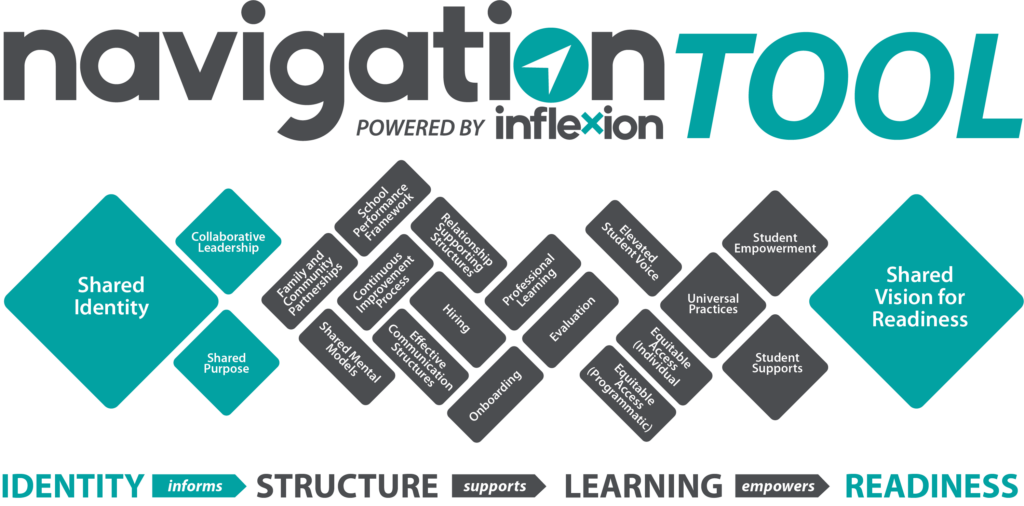The Inflexion Approach Navigation Tool is built on organizational theory and educational research that supports the importance of identity and a shared vision for readiness to guide school change efforts.

Schools that have a shared vision for readiness and a clear, shared school identity are positioned to succeed. A school’s identity and its vision for readiness serve as the anchors from which school leaders make decisions that lead to coherent organizational structures and aligned learning approaches. When such systems exist, schools are well positioned to understand the holistic needs of students and provide the necessary support for achieving educational equity across a range of student outcomes. School leaders can focus on the system as whole, and work to sustain the purpose of their school.
When schools do not have an established vision for readiness and shared identity, school leaders need to do the work of authentically engage the communities they serve to ensure they know who they are and where they want to go. With a solid sense of identity, school leaders can begin creating a shared vision for readiness that represents their community and speaks to the knowledge, skills, dispositions, and attitudes stakeholders envision most important for students’ success after high school.
The five steps described below take the components of the Inflexion Approach and break them into manageable chunks, a Navigation Tool, that school leaders can use as a guide to do the work of transforming their school.
The Five Step Inflexion Approach to School Transformation
- Establish Foundations
- Set Goals and Take Action
- Focus on Student-Centered Learning
- Transform
- Sustain
Step 1: Establish Foundations
Establish a shared understanding and purpose, a why, and a collective identity. Create momentum and accountability for the school’s purpose that is shared by all. This allows school leaders to look at systems and structures through the lens of what we are trying to accomplish for all students, and tap into the collective wisdom and energy of the entire school community.

Shared Identity
The school community knows who they are and what they collectively value and believe.
Shared Purpose
The school community is united in preparing each and every student for life.
Collaborative Leadership
Decision making power is shared among key influencers throughout the school community.
Step 2: Set Goals and Take Action
Co-create a vision of the skills, dispositions, and behavior that you are trying to achieve for all students. Find a north star, and backwards map from that vision to create the goals and identify the actions that will get you there. School leaders strengthen bidirectional communication with the entire school community, including families, to partner in supporting students.

Shared Vision for Readiness
The outcomes the school community prioritizes for each and every student.
Effective Communication Structures
Communication structures are simple, clear and well known throughout the school community.
Family and Community Partnerships
The school community purposefully works together to ensure all students get what they need.
Step 3: Focus on Student-Centered Learning
Understand what needs to happen in the classroom to make the shared vision for students a reality. Start with classroom practices and community based and asset based learning to create understanding and relevance, so students can learn what they are supposed to learn and develop the skills they need to be successful. Share strategies that enable students to see the relevance of what they are learning, and empower students to have voice and choice and reflect on their learning.

Universal Practices
Consistent approaches or strategies implemented across all classrooms and settings.
Student Empowerment
Each and every student has agency and autonomy in their learning journey.
Elevated Student Voice
Students’ ideas, experiences, and identities are centered in decisions that shape what and how they learn.
Step 4: Transform
As the impacts from steps one through three become visible, you can begin to focus on the mindset shifts and the systemic work that create results for students and changes adult behaviors and schoolwide structures. This allows for changes to any inequitable system and structures, and directly addressing barriers to success in the school.

Shared Mental Models
The set of beliefs and expectations that influence how we make sense of the world and guide our behavior and decision-making.
Relationship Supporting Structures
Rituals and routines that foster and sustain strong relationships.
Equitable Access (Individual)
Each and every student gets what they need when and how they need it.
Continuous Improvement Process
Diverse insights are used to make ongoing effective improvements for systemic sustainability.
School Performance Framework
A structured way to articulate and measure what it means to be an effective school.
Equitable Access (Programmatic)
The range of programs provided to students cater to their identities, interests, aspirations, and needs.
Step 5: Sustain
In order to maintain a strong school culture and continue to welcome and embrace the school community, the ways that new individuals are folded into the organization are critical to continue to have success. Healthy systems do not happen by accident, and constant attention is required to support the system. The makeup of the school, the professional learning needs of educators, and the support needs of students change over time and we can’t plan for every potential scenario. In order for the school culture to stand the test of time it is critical that the identity of the organization is central to all decisions, and all new additions to the school community are brought into the shared identity.

Hiring
Recruitment and selection of candidates who align with the school’s shared identity and purpose.
Onboarding
Structured activities and supports to integrate new staff into the school.
Student Supports
Targeted learning opportunities and resources.
Professional Learning
Professional development opportunities that help staff fulfill the school’s vision for readiness.
Evaluation
Process for assessing staff performance in alignment with a school’s shared vision, identity, and purpose.
